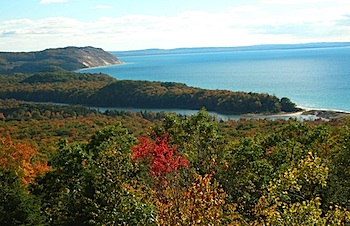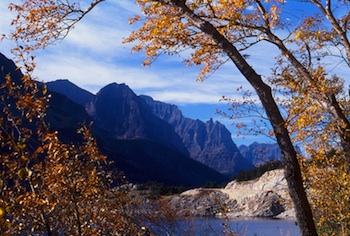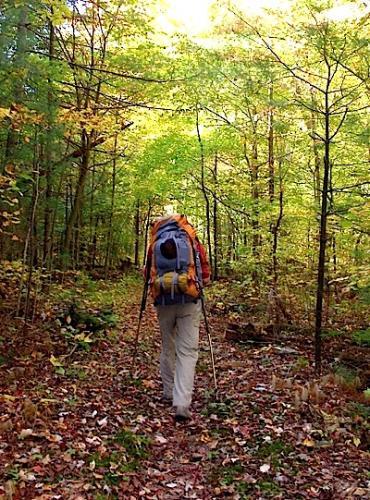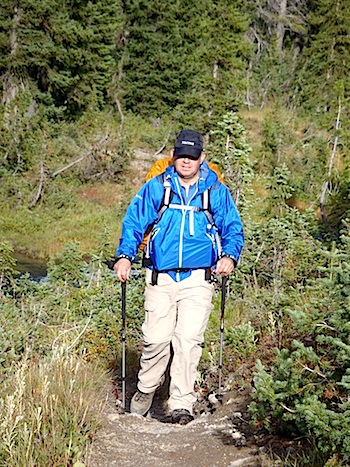Editor's note: There arguably is no better time for hiking in the National Park System than fall. The season brings fine weather to most of the country, and in many locations brilliant foliage is a bonus. Cool, bug-free conditions exist in many parks, and crowds are on the wane. With so many parks, there isn’t time enough for us to tackle each hike out there. But here are some suggestions for some great ones all across the nation.
Fall hiking in the East conjures immediate thoughts of Acadia National Park in Maine, Shenandoah National Park in Virginia, or Great Smoky Mountains National Park in North Carolina and Tennessee. All three are justly famous for fall color, have hundreds of miles of hiking trails…and lots of traffic on the roads, especially on autumn weekends.
If you’re looking for some options for a fall hike in a park that might not be quite so crowded, you might consider the following areas:
• Marsh-Billings-Rockefeller National Historical Park in Vermont dangles the chance to “Walk through one of Vermont’s most beautiful landscapes, under the shade of sugar maples and 400-year-old hemlocks, along winding woodland carriage roads and trails. On the gentle slopes of Mount Tom you will find mountain pastures, a mysteriously-named pond, and spectacular views of nearby hills and valleys.”
• Not terribly far from the Smokies, Big South Fork National River and Recreation Area straddles the Kentucky-Tennessee border. The park’s 125,000 acres include miles of scenic gorges and sandstone bluffs and is rich with natural and historic features. Two hikes stand out in fall: the Angel Falls Rapids hike from Leatherwood Ford (four miles round trip) and the Twin Arches/ Twin Arches Loop Trail (1.4 miles round trip to Arches only or 6 miles total for the complete loop).
* Where Virginia, Kentucky and Tennessee come together, Cumberland Gap National Historical Park combines history and scenery spread across 20,500 acres of rugged mountain beauty threaded with 85 miles of trails.
• Mammoth Cave National Park in Kentucky has plenty to see above ground. The Green River Bluffs Trail near the visitor center winds through a ridge-top forest. This trail overs some nice vistas from 150 feet above the river. The Cedar Sink Trail, meanwhile, is a two-mile trek through woods to a huge sinkhole that has a river running through the bottom.
* Sleeping Bear Dunes National Lakeshore in Michigan gets plenty of colorful mileage from the area’s maple, beech and birch trees. The Empire Bluff, Pyramid Point, Alligator Hill, and Windy Moraine trails are great hikes, and all but the Windy Moraine Trail eventually lead to a view of Lake Michigan from a high bluff. Windy Moraine overlooks the Glen Lakes, beautiful inland lakes wrapped by forest.

The view across Empire Buff, North Bar Look, and Lake Michigan in Sleeping Bear Dunes National Lakeshore. NPS photo.
• Pictured Rocks National Lakeshore is home to miles of pristine beaches and more than 100 miles of trails woven through a northern hardwood forest. Try the trail that runs from the Chapel parking lot to Mosquito River at Lake Superior (about 1.7 miles one way) and then return via the Mosquito Falls trail.
• To the south, the Buffalo National River in Arkansas offers more than 100 miles of hiking trails through the rocky bluffs and hardwood forests of the Ozarks that complement river trips. A popular short hike, the Lost Valley Trail, features waterfalls, towering cliffs, a large bluff shelter, a natural bridge and a small cave. The cave runs about 200 feet and ends in a large room with a 35-foot waterfall. The trail begins at the Lost Valley Campground; the round trip covers 2.1 miles.
• Cedar Breaks National Monument in Utah just might be one of the top ten places to experience fall colors in the United States. Park staff recommend the Alpine Pond Nature Trail as the hike to take for fall color. Rated as “easy to moderate in difficulty,” it’s a two-mile, double-loop route through forests and meadows. The lower trail offers excellent views of the “breaks,” the colorful, eroded badlands where the edge of theMarkagunt Plateau breaks away to a lower area, while the upper trail takes you across meadows, through a spruce-fir-aspen forest, and by ancient volcanic deposits. Half-way through the loop, a natural, spring-fed pond offers a quiet location for a break. A cut-off trail at the pond allows you to make this hike a one-mile loop. A small stand of bristlecone pines can also be viewed from this trail.
• Glacier National Park offers outstanding fall hikes, including one of my personal favorites. West of St. Mary along the classic Going-to-the-Sun Road is the Sun Point Nature Trail. The trail covers about a mile each way, and includes the chance for some premier views of Saint Mary Lake with rugged mountain peaks in the background. You can return to your car from Sun Point or continue a short distance to Sunrift Gorge, a straight, steep canyon formed when a small stream cut through a natural break in the rock. For a longer, half-day hike, you can carry on to St. Mary Falls and Virginia Falls.

Glacier National Park offers more than a few great hikes, some with views such as this one out across St. Mary Lake. Jim Burnett photo.
* Fall is the perfect season to hike in Petrified Forest National Park in Arizona, as the lack of a forest canopy makes the trail system a scorcher in summer. But with fall’s cooler temperatures, a walk along the Blue Mesa, Crystal Forest, or Long Logs trails is delightful.
• Rocky Mountain National Park is a magnet for hikers. Many day hikers head to the Bear Lake area, and the trail to Nymph, Dream, and Emerald lakes is one of the main reasons. Another is the path to Alberta Falls. Just get there early, preferably around sun-up, to land a parking spot and enjoy the solitude of the mountains.
• West Coast travelers looking for an option to Yosemite might try Whiskeytown National Recreation Area in northern California. For fall day hikes, consider the Brandy Creek Falls Trail (1.5 miles round trip) and the James K. Carr Trail to Whiskeytown Falls (3.4 miles round trip). Both are rated by the park as “moderate” in difficulty. Two foot bridges on the route to Brandy Creek Falls allow you to access the falls during high winter flows.
Looking for a long-distance fall hike?
Here are a handful to consider:
• Anywhere along the Appalachian National Scenic Trail. This wonderful 2,184-mile path offers gorgeous fall color anywhere along its route, though the best might be in Shenandoah and Great Smoky Mountains national parks or along the Blue Ridge Parkway. You can hike for a few days, or a few weeks, before winter arrives.
Yellowstone's backcountry in fall is sublime. Kurt Repanshek photo.• Yellowstone National Park’s backcountry is uncrowded throughout the year, but particularly so in the fall. Those who venture into the Bechler region, aka Cascade Corner, in the fall have no bugs to contend with and spectacular waterfalls to enjoy. Those who know where “Mr. Bubbles” is even can soak in the outflow of a hot spring that is cooled by the Ferris Fork of the Bechler River.
• The Under-the-Rim Trail at Bryce Canyon National Park is 23 miles long, perfect for a three-day getaway that surrounds you with fall foliage and rainbow hues of the park’s eroded sandstone.
• The John Muir Trail through Yosemite, Kings Canyon, and Sequoia national parks is very popular, and early fall -- before it gets too wintry -- is a great time to avoid the crowds on it.
• September is a wonderful month to hike the Wonderland Trail around Mount Rainier National Park, though nabbing a permit at the last minute is tough if not impossible. October can be good, too, but you chance an early season snowstorm.



 Support Essential Coverage of Essential Places
Support Essential Coverage of Essential Places







Comments
Jim,
Thanks for the information! I went to Great Smoky Mountains National Park last fall and it was a nightmare. The traffic and congestion was horrible. The trails were overcrowded. You could not even find a parking space for your car at the trailheads. I've always wanted to visit Cumberland Gap National Historic Park. I might give it a go if it is not too late in the season for fall colors.